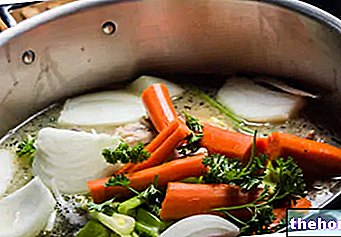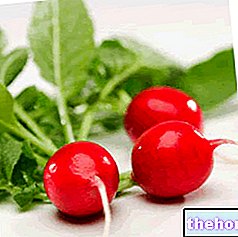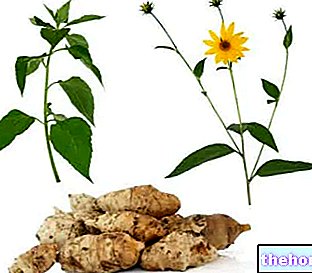Generality
The term Gazpacho it mainly refers to some gastronomic recipes typical of Hispanic cuisine.
It is a type of cold soup containing stale bread, olive oil, vinegar and raw vegetables; among the latter, tomatoes, cucumbers, peppers, onions and garlic are usually preferred.

The origin of the “current” gazpacho is uncertain, even if it is considered a typical dish of the Andalusian hinterland (Andalusia); here, the summer climate is hot and dry, therefore some products such as olive oil or vegetables are common and abundant. For this reason, the term “gazpacho” (without specifying which) is intended as a synonym for “gazpacho andaluz” (ie Andalusian).
The invention of the dish of finely chopped vegetables, typical of these territories, seems to precede the period of al-Andalus (Islamic conquests of the Iberian Peninsula; 7th-8th century AD). It is also true that the "primitive" gazpacho (mixture of crumbled bread with olive oil and vinegar) has been part of the peasant diet of the southern Iberian territories for many centuries; its history and the consequent local diversification have allowed the birth of many recipes spread between Spain and Portugal.
As the literature shows, the first gazpachos have evolved to obtain the contemporary Andalusian one. There are several versions, some hot, others cold. Among the latter are distinguished: ajoblanco and salmorejo. As for the hot ones, however, the most characteristic are from La Mancha and are called gazpachos manchengos (galianos); some hot versions are however also widespread in Andalusia.
The finds indicate that the presence of tomatoes was only introduced in the 19th century. In ancient times, “gazpacho” was a generic term for any type of soup made from crushed foods, including: bread, oil, vinegar, salt and other ingredients.
Andalusian gazpacho
The Andalusian gazpacho is very famous. Some authors define it as a cross between a soup and a "salad. In most cases, it is now used as a summer drink. Although there is no evidence to prove it, some authors suspect that Andalusian gazpacho originated in Seville. .
It is said to have been Andalusian for being so transcended to other regions of Spain and the world but, in Andalusia, there are both white gazpachos that do not contain tomato (such as cordoba), and red gazpacho that instead include it in the recipe.
The red gazpachos are mainly made in Western Andalusia, while the white one in Malaga, Cordoba and Granada; the green gazpacho is typical of the Sierra Morena and Sierra de Huelva.
Andalusian Gazpacho recipe
Gazpacho differs according to the mixture of vegetables that compose it.
The ingredients of the Andalusian gazpacho include a mix of five vegetables, which varies according to: tastes of the operator, production area, season and family tradition.
- Tomatoes: they must be ripe to give sweetness; once, this was only possible in summer and early autumn but, with the development of greenhouses and the transport network, they could be used all year round; this vegetable also gives the red color, thanks to its content of lycopene (natural pigment The addition of tomatoes produces a red gazpacho, otherwise a green or brownish color. In some periods of shortage, sweet paprika was used to obtain the same shade.
- Cucumber: lends itself to the combination with vinegar. The flavor is strong and its quantity must be weighted according to the other ingredients. When the recipe does not include the use of cucumber it is also called "soft gazpacho". Both typical cucumber properties, such as sour taste and high water content, are ideal for quenching thirst.
- Peppers (red or green). The non-spicy pepper is a vegetable that gives freshness and hints of citrus.
- Onions. They are present in variable quantities depending on the aroma that you want to give.
- Garlic. In small quantities it produces a characteristic scent. One of its functions in gazpacho is to emulsify the vegetable "olive oil".
- Bread is used to increase the volume of gazpacho or to thicken it, but when used as a refreshing drink it is almost absent. In the traditional recipe, the leftover stale bread soaked in water and oil is used.
NB. Carrots are allowed but still represent an obsolete ingredient. - What remains is the olive oil, vinegar, water and salt. High quality products are used, and the Spaniards are familiar with the saying "Con mal vinagre y peor aceite, buen gazpacho no puede hacerse".
Gazpacho with Tomatoes, Peppers and Cucumbers
Problems with playing the video? Reload the video from youtube.
- Go to the Video Page
- Go to the Video Recipes Section
- Watch the video on youtube
Other Types of Gazpacho
In addition to the andaluz, there are other types of gazpacho; we mention:
- Gazpachos manchegos, also called galianos, is a Castilian dish, especially from La Mancha. It is a thick stew served hot with pieces of cenceña machega cake. It is accompanied by small pieces of rabbit, chicken, partridge or hare. In some areas, mushrooms are also added (chanterelles, pioppini, etc.). Thanks to its geographical proximity and climate, this dish is also popular in Valentia, especially in the districts of Vinalopo, up to the coastal cities of Alicante, where it is also enriched with seafood. In the province of Valencia it is widely cooked especially in the regions of Valle de Ayora, Hoya de Buñol, Costa, Requena-Utiel and Channel Navarrés, where the term machengo is often replaced with the name of the city; the dish is essentially the same.
- Gazpacho viudos (or widows), is a manchego devoid of meat ingredients (hence the name). Essentially, it is a simply vegetarian missing variant. It usually consists of tomatoes, yeast-free cake, sometimes colleja (aromatic herb), potatoes etc.
- Gazpacho de jeringuilla (or syringe), typical of some areas of Andalusia, is a kind of caponata that contains an abundant quantity of liquid. In addition to many vegetables, an "emulsion of olive oil, vinegar and salt is used. It is served in the summer months, cold or frozen, in the typical bowls. Unlike other gazpachos, which are finely chopped or blended, this one is only chopped. .
- Gazpacho alicantino (or from Alicante), is a gazpacho typical of the mountainous (non-maritime) area of the province of Alicante. Contains mixed meats and breadcrumbs from focaccia or unleavened bread. The meats are traditional game: wild rabbit, hare or partridge. Currently, miscellaneous poultry is also added. A characteristic of alicantino gazpacho is that, usually, they are served on special loaves.
- Gazpacho medicano or moreliano, is a Mexican fruit salad with mixed vegetables, cheese and chilli.
These are the main types of food but, to make a comparison, it could be said that throughout the Iberian Peninsula there are as many gazpacho recipes as there are Italian formulas for dry pasta.
Nutritional Composition
Gazpacho is a moderate source of dietary energy, supplied mainly by carbohydrates, which are associated with a good amount of fiber. Generally, 100ml of gazpacho contains 44-55kcal, depending on the bread content (main energy source, attributable to the concentration of starch).
Nutritional values

Gazpacho is also a natural source of mineral salts, vitamins (hydro and fat soluble) and other antioxidants.
Among the vitamins of gazpacho, the most important are certainly: vitamin C (mainly thanks to peppers), vitamin A and vitamin E.
As regards the mineral salts, the contributions of phosphorus, iron, calcium, magnesium, manganese, zinc, copper, potassium and sodium are distinguished. Thanks to the composition of these micro and macro elements (especially potassium), gazpacho is considered an isotonic drink; this characteristic is very important in maintaining efficient body hydration, avoiding both dehydration and hyperhydration (the latter only in predisposed subjects).
Among the non-vitamin antioxidants of gazpacho, the most important is certainly lycopene, responsible for the characteristic red color of tomatoes; there is no shortage of carotenoids (pro-vitamin A), instead responsible for an orange color. The pigment content is higher the more mature the vegetable is.
Gazpacho also possesses various phenolic compounds in the vegetables themselves.
The garlic content also gives the recipe some vaso-dilating properties, therefore anti-hypertensive.
In dietetics, gazpacho is used as a satiating product, a characteristic already demonstrated in various studies on humans (for example in «The effect of soup on satiation», Appetite, vol. 30, no2, pp. 199-210 [1 p.1 / 4]).
The consumption of gazpacho provides a not negligible positive health implication, thanks to the presence of vitamins, mineral salts, polyphenols and other antioxidants; however, the high use of vegetables could have negative implications. In fact, it is suspected that pesticide levels in vegetables may be high enough to exceed safe levels for frequent consumption.
The industrial processing of packaged gazpacho also involves the use of pasteurization (to increase its shelf life); on the other hand, this procedure reduces the content of thermolabile molecules, such as vitamin C and other antioxidants. In this regard, food technological research has launched a scientific protocol of alternative experimentation; these are the impulses of electric fields, which should limit the microbiological charge, leaving the nutritional molecules intact.
Regular consumption of gazpacho in the diet can help reduce the risk of cancer thanks to an increased intake of vegetables.
Other Foods - Vegetables Garlic Agretti Asparagus Basil Beets Borage Broccoli Capers Artichokes Carrots Catalonia Brussels sprouts Cauliflower Cabbage and Savoy cabbage Red cabbage Cucumber Chicory Turnip greens Onion Sauerkraut Watercress Edamame Chives Chanterelles Flour Cassava Flowers Pumpkin Flour Edible Flowers Pumpkin Seasonal Fruits and Vegetables Endive Salads and Salads Strengthening Salad Lettuce Aubergines Vegetables Nettle Pak-Choi Parsnip Potatoes American Potato Peppers Pinzimonio Tomatoes Leeks Parsley Radicchio Turnips Red Turnips Radishes Rocket Shallots Endive Celery Celeriac Seeds Sprouted Spinach Truffle Valianamberi or Jerusalem artichoke laxatives Saffron Pumpkin Zucchini Vegetables - Nutritional properties OTHER VEGETABLE ITEMS Categories Food Alcoholics Meat Cereals and derivatives Sweeteners Sweets Offal Fruit Dried fruit Milk and derivatives Legumes Oils and fats Fish and fishery products Cold cuts S pezie Vegetables Health recipes Appetizers Bread, Pizza and Brioche First courses Second courses Vegetables and Salads Sweets and Desserts Ice creams and sorbets Syrups, liqueurs and grappa Basic preparations ---- In the kitchen with leftovers Carnival recipes Christmas recipes Light diet recipes Women's Day, Mum, Dad Recipes Functional Recipes International Recipes Easter Recipes Recipes for Celiacs Recipes for Diabetics Recipes for Holidays Recipes for Valentine's Day Recipes for Vegetarians Protein Recipes Regional Recipes Vegan Recipes



















-nelle-carni-di-maiale.jpg)








